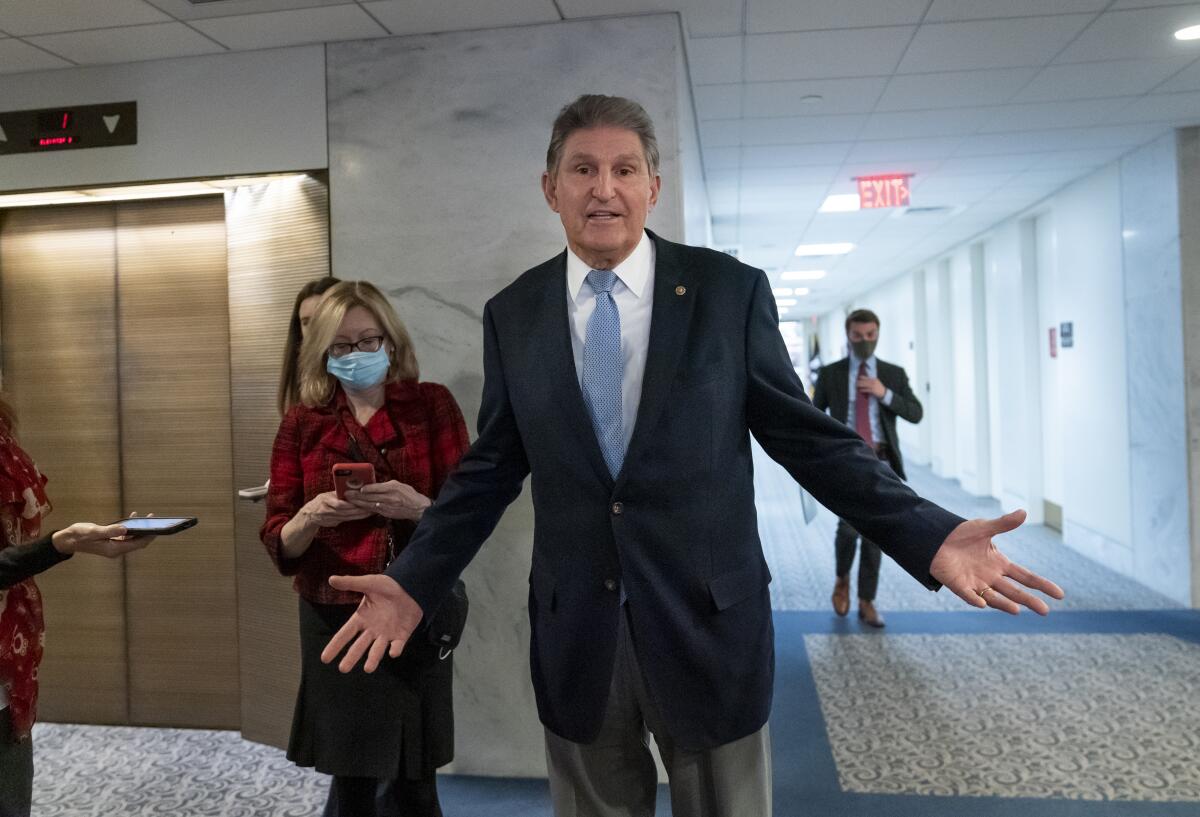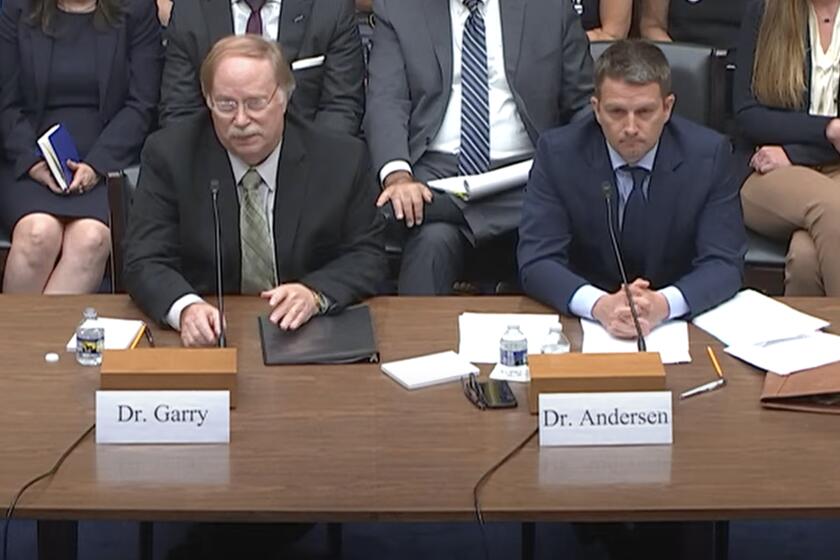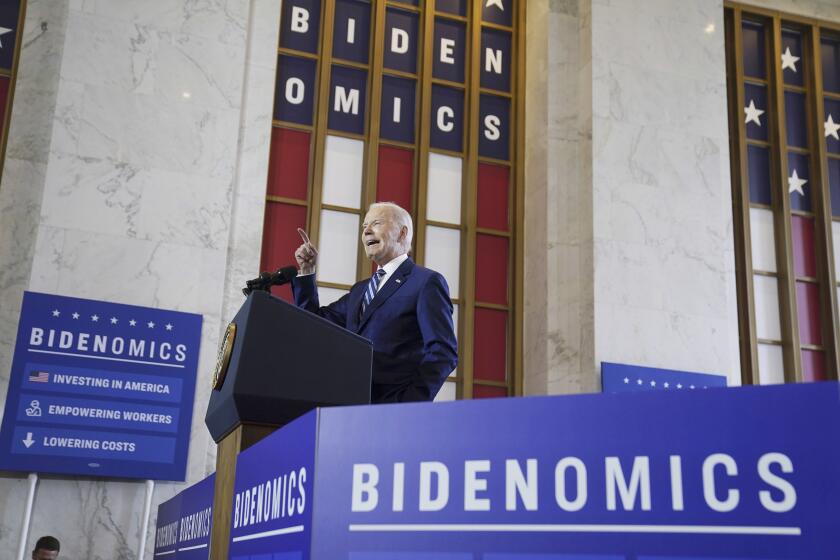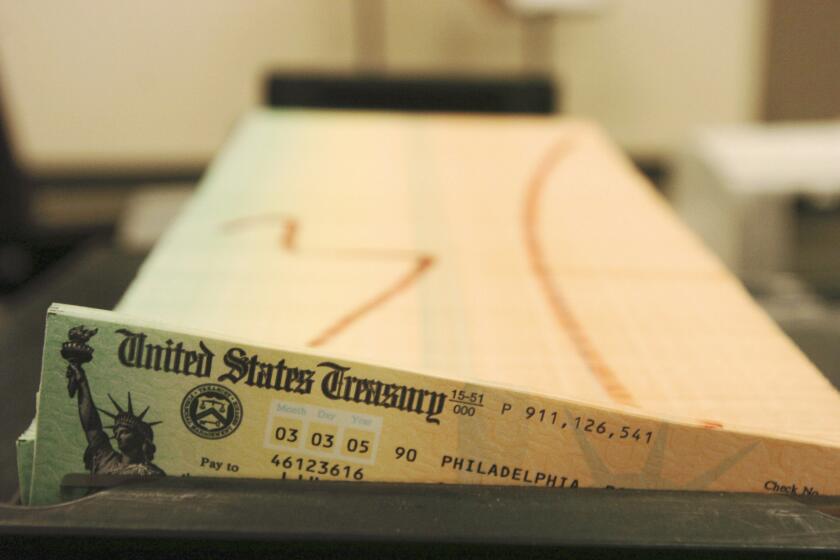Column: The false centrism of political group No Labels

- Share via
Presidential campaigns start earlier and earlier these days, and so too do pleas that politics in the U.S. would be so much more effective if we could, in the words of Rodney King, “all just get along.”
So here comes the purportedly centrist political group No Labels, which recently released a 72-page political manifesto titled “Common Sense,” in an overt echo of Thomas Paine.
“Most Americans are decent, caring, reasonable, and patriotic people,” declares the document’s preamble. “Instead, we see our two major parties dominated by angry and extremist voices driven by ideology and identity politics rather than what’s best for our country.”
No Labels says it may back a third-party candidate for president next year unless President Biden seems to be running well ahead of Donald Trump. That sounds more like a threat than a promise.
We see our two major parties dominated by angry and extremist voices driven by ideology and identity politics rather than what’s best for our country.
— No Labels tries to both-sides the extremism of the GOP
The politician the group has been most assiduously promoting lately is Sen. Joe Manchin III (D-W.Va.). Manchin has demonstrated his centrist bona fides by doing things such as killing an expansion of the Child Tax Credit, an anti-poverty program of proven effectiveness, and blocking initiatives for renewable fuels in favor of protecting coal and other fossil fuels (he’s an investor in the coal industry).
That might tell you all you need to know about No Labels, but there’s more. The organization doesn’t disclose its donors, but Mother Jones has reported that they include private equity investors, a natural gas billionaire, and real estate and insurance industry figures.
Get the latest from Michael Hiltzik
Commentary on economics and more from a Pulitzer Prize winner.
You may occasionally receive promotional content from the Los Angeles Times.
The best window into No Labels’ approach is its “Common Sense” policy document, which boasts of providing “a clear blueprint for where America’s commonsense majority wants this country to go.”
Would that were so. In the flesh, the document is an agglomeration of misinformation, platitudes and premasticated nostrums.
The document tends to make its points by listing problems and saying, in effect, “something must be done” — but doesn’t give many specifics about what that something would be. It makes assumptions about what is desired by “commonsense Americans” (whoever they are) without actually showing that its assumptions are valid.
Housing? “Building more homes in America will make housing more affordable for Americans,” says No Labels. No kidding? So what are you going to do about it? The policy document doesn’t say, beyond endorsing a couple of federal tax credit proposals in Congress that on the gonna-happen scale are a “not.”
House Republicans used an oversight hearing to accuse former NIH officials Anthony Fauci and Francis Collins of complicity in the COVID pandemic. The loser in this cabaret is science.
On some issues, No Labels merely tries to split the difference between two sides, never mind that one side may be right and the other wrong. Abortion? No Labels calls for a “compromise” between the belief that “women have a right to control their own reproductive health and our society’s responsibility to protect human life.”
That word salad gets us nowhere, skating glibly over the Supreme Court’s overturning of Roe vs. Wade, as played out in states where stringent antiabortion statutes have had devastating consequences for the health of pregnant women and their access to medical care. If that’s the best that No Labels can offer, why does the organization exist at all?
Social Security? No Labels calls its fiscal condition “a textbook example of how leaders kick the can down the road in a manner that makes a foreseeable problem even harder to solve for the next generation.” This is a textbook example of balderdash.
“The longer Washington waits to fix Social Security,” No Labels says, “the harder it will be to do so.” The truth, as the political geniuses behind No Labels surely understand, is just the opposite. The closer a deadline, the easier it is to bring people together for a solution.
No Labels bases its argument on the fact that if Congress defers a decision on shoring up the program’s finances, the solutions will require more stringent benefit cuts or tax increases than they would today. But acting now would mean reducing benefits or raising taxes long before that’s necessary, and possibly more than will be necessary.
And who would pay that price? No Labels says that “no one in retirement — or close to it — should face any benefit changes.” Why not? Why place the burden of benefit cuts only on the younger generation? If “fixing” Social Security is “a challenge that we can and must solve together,” how come those in their fifties or older get a free pass?
Inflation is down sharply, employment is holding steady and GDP is growing. But Americans are still blaming Biden for a lousy recovery.
The real reason that Social Security may need more funding is that wealthier Americans aren’t paying their fair share of the payroll tax that funds most benefits. Removing the cap on the payroll tax, which exempts wage income over $160,200 (this year’s limit), would eliminate almost all the program’s funding deficit for the foreseeable future. But that, obviously, would hit the taxpayer class No Labels seems determined to protect.
We can see that in the organization’s hand-wringing over the federal debt: “Our overall debt-to-GDP ratio is 120% and it is getting worse by the day.”
A few points about this. First, as frightening as this formula makes the debt sound, whether it’s meaningful is highly questionable. GDP is a snapshot of the current economy, debt is paid down over time — 10 or even 30 years. Some of this debt may never actually come due, since the U.S. has the capability of rolling over its debts in perpetuity.
In any case, the figure of 120% is misleading, because it doesn’t net out federal debt held in federal accounts — in effect, debt the government owes to itself. Debt held by the public (including foreign investors) currently comes to about 100% of GDP and is projected to reach about 107% in 2028. The last time the ratio was this high was in the late 1940s, reflecting the cost of waging World War II.
That was a crisis, and the current level of debt also reflects a crisis — the COVID-19 pandemic, in which the government protected millions of Americans from financial disaster through trillions of dollars in assistance. Was that a bad choice? No Labels seems to say so, but it’s doubtful that many households would agree.
A more appropriate ratio is interest-to-GDP. The government’s interest bill comes to about 1.7% of GDP this year, according to the Congressional Budget Office. The CBO projects that the annual average will work out to about 2.6% over the next decade.
The rich won’t be hurt a bit by the Biden/McCarthy debt ceiling deal. It’s the poor who will pay. That was Republicans’ priority all along.
Is that a crushing burden? As economist Dean Baker has pointed out, it has been higher in the past. It was about 3% during the 1990s. That was a “very prosperous decade,” during which the debt burden was not seen as much of a problem.
As a result of the Federal Reserve Board’s run-up in interest rates over the last year, government securities are paying higher rates. Whether this is bad news depends on where you sit. It could be a boon for seniors dependent on fixed-income investments, for instance. They’ve been struggling with minimal returns for years as interest rates touched zero percent. Today, however, one-year T-bills yield about 5.3% and 10-year notes more than 3.7%, annualized.
No Labels calls for a deficit reduction commission to issue proposals for spending cuts and revenue increases that Congress would have to vote on as a unified package. The model here is the Simpson-Bowles Fiscal Responsibility Commission of 2010. No Labels recalls its report as “sensible and responsible, and dead on arrival.”
That’s a neat bit of historical revisionism. The reason the report went nowhere was that the commission itself was so split that it never got around to issuing recommendations at all. The co-chairs, the noxious former Sen. Alan Simpson (R-Wyo.) and the conservative Democrat Erskine Bowles, traveled the country trying to sell their snake oil, with no success.
The truth was that the commission was a front for the wealthy. The Simpson-Bowles plan was a road map for cutting services and benefits for the working and middle class — including Social Security, Medicare and Medicaid benefits and disaster relief — while preserving the tax breaks that the rich valued most highly. By taking Simpson-Bowles as a model, No Labels shows us what it’s really about.
Don’t listen to the doomsayers: Social Security is healthy today, and the U.S. is rich enough to improve it — if the wealthy pay their fair share.
Some of the policy document’s “ideas” are based on popular mythologies and received wisdom (or really, received misinformation). Some are self-contradictory. On crime, for example, the document says, “Americans are worried about the surge of crime,” but two paragraphs later acknowledges that violent crime is “down 44% since the 1990s.”
What’s the solution? To No Labels, it all boils down to putting more cops on the street. “It’s a simple equation: the more cops patrolling a given community, the less crime that community experiences.” There’s no hint there that among law enforcement experts this is a heavily disputed claim.
It’s based on dubious data and a very narrow definition of “crime” — leaving out offenses such as wage theft and air and water pollution, for instance — and overlooks numerous proven approaches to reducing street crime that don’t require more cops. Nor does it recognize that in some contexts, more police leads to more crime. But why claim to be exploring the complexity of criminal justice, when you’re just parroting the simple-minded conclusion that more cops invariably make a community safer?
On these and many other issues, No Labels is claiming to map out a middle ground between Democrats and Republicans that doesn’t really exist. No Labels says its goal is to combat political polarization in America, but the country is not, in fact, polarized. Large majorities favor abortion rights, gun control, making the rich pay their fair share in taxes, and protecting voting rights.
No Labels tries to both-sides the GOP’s allegiance to an extremist former president and its platform of eliminating abortion rights, constricting voting rights and advancing discrimination against racial and ethnic minorities and LGBTQ+ individuals. That Democratic Party policies are the polar opposites of those hardly makes it as “extremist” as the GOP. Where’s the middle ground when one side wants to expand rights and opportunities, and the other wants to destroy them?
More to Read
Get the latest from Michael Hiltzik
Commentary on economics and more from a Pulitzer Prize winner.
You may occasionally receive promotional content from the Los Angeles Times.















